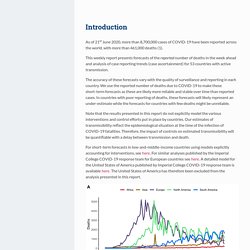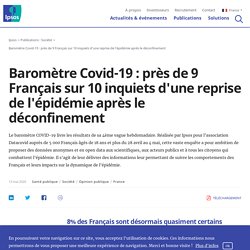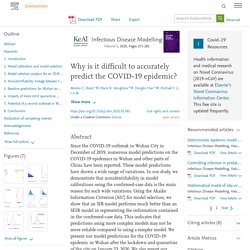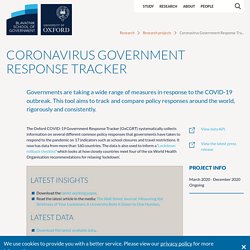

COVID-19 transmission model. Short-term forecasts of COVID-19 deaths in multiple countries. As of 21st June 2020, more than 8,700,000 cases of COVID-19 have been reported across the world, with more than 461,000 deaths (1).

This weekly report presents forecasts of the reported number of deaths in the week ahead and analysis of case reporting trends (case ascertainment) for 53 countries with active transmission. The accuracy of these forecasts vary with the quality of surveillance and reporting in each country. We use the reported number of deaths due to COVID-19 to make these short-term forecasts as these are likely more reliable and stable over time than reported cases. In countries with poor reporting of deaths, these forecasts will likely represent an under-estimate while the forecasts for countries with few deaths might be unreliable. Note that the results presented in this report do not explicitly model the various interventions and control efforts put in place by countries.
Figure 1. We define a country to have active transmission if. GISAID - Initiative. Center for Global Health (CGH) Outbreak investigation The CGH has set up a task force of public health rapid responders that can be contacted by national and international authorities to help respond to pandemic threats.

This Outbreak Investigation Task Force can be mobilized in a matter of days in the event of an infectious outbreak anywhere in the world. It is composed of around fifty scientists from the Institut Pasteur International Network and draws on an extensive pool of expertise ranging from epidemiology to microbiology to entomology to veterinary science. The Institut Pasteur's presence in 26 countries is a major advantage when it comes to responding to local epidemics. This network has first hand field experience with the world’s deadliest pathogens including Ebola, SARS, MERS-CoV, avian influenza, yellow fever, and plague. Research to improve human health The Institut Pasteur has gained worldwide renown for the excellence of its research and is a leading player in tackling global health threats. Faculty of Medicine. Baromètre Covid-19 : près de 9 Français sur 10 inquiets d'une reprise de l'épidémie après le déconfinement.
8% des Français sont désormais quasiment certains d’avoir eu le coronavirus : un chiffre stable mais dont l’évolution va devoir être suivie avec attention 1% des Français dit avoir été testé positif, seulement 3% déclarent avoir eu les symptômes et consulté un médecin et 4% disent les avoir ressentis mais n’ont pas consulté (chiffre stable), soit un total de 8% d’individus qui estiment qu’il y a des risques très sérieux qu’ils aient eu le coronavirus.

Ce taux de contamination déclaré est resté extrêmement stable au cours des 4 dernières vagues du baromètre, son évolution devra être suivie très attentivement au cours des prochaines semaines. Des motifs d’inquiétude : dans certaines régions l’application des gestes de distanciation sociale recule. Les comportements de distanciation sociale, gestes essentiels pour faire barrière au Covid-19 semblent de plus en plus compliqués à suivre. Autre point sensible, un Français sur trois déclare avoir des doutes les consignes de port du masque (33%). Strategic Intelligence. Why is it difficult to accurately predict the COVID-19 epidemic? 1.

Introduction In early December 2019, a novel coronavirus, later labelled as COVID-19, caused an outbreak in the city of Wuhan, Hubei Province, China, and it has further spread to other parts of China and many other countries in the world. By January 31, the global confirmed cases have reached 9,776 with a death toll of 213, and the WHO declared the outbreak as a public health emergency of international concern (WHO, 2020).
By February 9, the global death toll has climbed to 811, surpassing the total death toll of the 2003 SARS epidemic, and the confirmed cases continued to climb globally. As governments and public agencies in China and other impacted countries respond to the outbreaks, it is crucial for modelers to estimate the severity of the epidemic in terms of the total number of infected, total number of confirmed cases, total deaths, and the basic reproduction number, and to predict the time course of the epidemic, the arrival of its peak time, and total duration. 2. 2.1. 2.2.
Coronavirus Government Response Tracker. The Oxford COVID-19 Government Response Tracker (OxCGRT) systematically collects information on several different common policy responses that governments have taken to respond to the pandemic on 17 indicators such as school closures and travel restrictions.

It now has data from more than 160 countries. The data is also used to inform a ‘Lockdown rollback checklist’ which looks at how closely countries meet four of the six World Health Organisation recommendations for relaxing ‘lockdown’. Stringency and policy indices OxCGRT collects publicly available information on 17 indicators of government responses. Eight of the policy indicators (C1-C8) record information on containment and closure policies, such as school closures and restrictions in movement. The data from the 17 indicators is aggregated into a set of four common indices, reporting a number between 1 and 100 to reflect the level of government action on the topics in question:
Coronavirus COVID-19 (2019-nCoV) Lancet Inf Dis Article: Here.

Mobile Version: Here. Data sources: Full list. Downloadable database: GitHub, Feature Layer. Lead by JHU CSSE. Technical Support: Esri Living Atlas team and JHU APL. Nextstrain. Nextstrain.